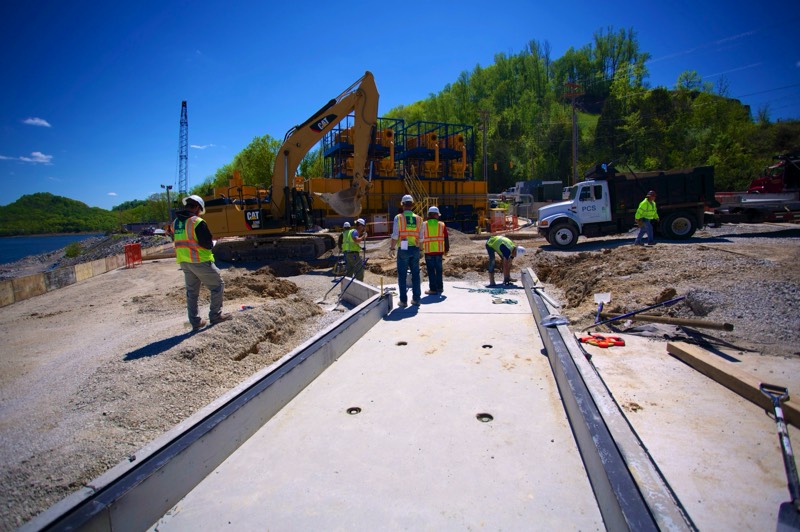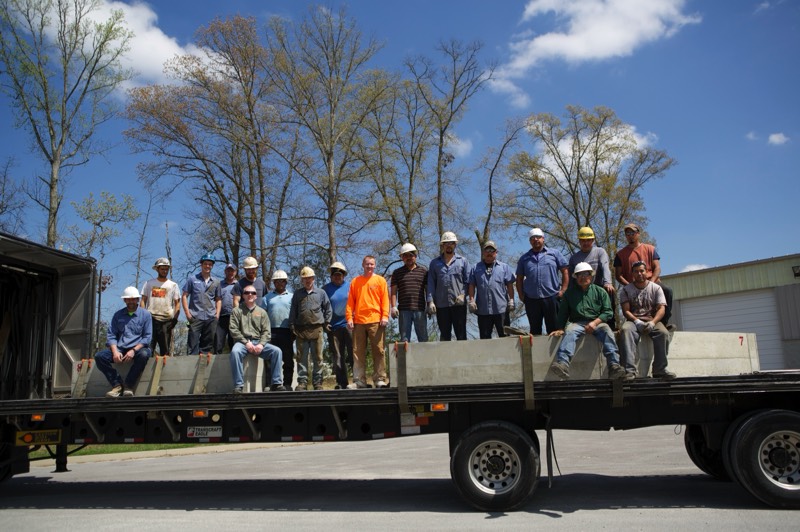Center Hill Dam 2013 - Precast Utility Trench
Rapid Response - C.R.Barger & Sons., Inc., answers the call of duty and successfully engineers, builds, and delivers a complex precast project within an extremely tight time frame.
Rapid Response - C.R.Barger & Sons., Inc., answers the call of duty and successfully engineers, builds, and delivers a complex precast project within an extremely tight time frame.
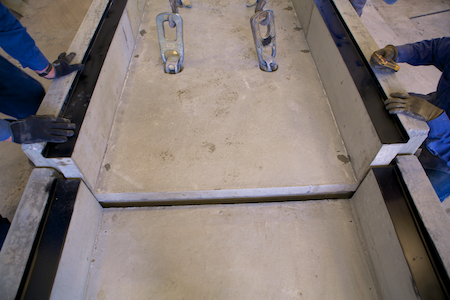
Led by the Army Corps of Engineers, the rehabilitation project encompassed four large construction contracts, the first addresses the most critical parts of the dam that have been affected by seepage, the earthen embankment of the main dam, and the left rim. BAUER Foundation Corporation kicked off the $106 million job (of $295 million for the company project) by constructing a subsurface concrete wall designed to keep “Center Hill Dam safe for generations to come,” according to the Corps.
BAUER Foundation is using specialty excavation equipment to remove long columns of the earthen dam and rock foundation and replacing them with concrete. The concrete columns will overlap to form a long, continuous concrete wall or “curtain” that will act as a barrier for potentially harmful seepage water moving beneath the earthen dam. The continuous concrete wall is the major feature of the dam rehabilitation and comprises a vertical concrete wall that extends down over 300 feet beneath the top of the dam (which includes over 100 feet into rock).
To engineer and build one critical component of the project, contractor Putnam Contracting Services, Inc., of Cookeville, Tenn., called on C.R. Barger & Sons. “We’d worked with them before and we liked their service and product quality,” says Chad Gilbert, principal at Putnam Contracting Services. “As a company, Barger and Sons is wired just like we are – with an aggressive, savvy, and ‘get it done’ mentality that you can’t find just anywhere.”
Tight Time and Construction Tolerances
This particular project presented some unique challenges for the contractor and the precaster, both of which were expected to deal swiftly and efficiently with a major undertaking. Gilbert says he knew Barger & Sons was up to the challenge. “When we need something done right and on time, going to them is an obvious choice,” says Gilbert. “We did not even shop around for precasters; we knew exactly where to go.”
Barger & Sons’ plant manager Phil Watson distinctly remembers the day that Gilbert’s call came in, asking if the precaster could engineer, build, and deliver a 200-foot precast trench within five days. “Eric Barger [the company’s vice president] approached me on a Thursday afternoon, asking if this was something we could produce within a very tight time frame,” Watson recalls. “I said sure, and we started putting together a game plan for getting the products made and delivered.”
Over the next five days, Watson and his production team worked about 85 hours to ensure timely delivery of the 16-foot-long precast pieces that would be used to build a 200-foot-long, Y-shaped trench. Speed of design, engineering, and manufacturing was of the utmost importance for Barger & Sons, which couldn’t sacrifice product quality and integrity when meeting its extremely short deadline.
To complete the project, Barger & Sons called on a local machine shop to produce a custom-rolled metal lip that would be installed on the trench. The lip required tight, ¼-inch tolerances that the machine shop surpassed. “They were able to fulfill the order within an eighth of an inch,” says Watson. “That precision made our job a little easier and allowed us to focus on the precast aspect of the job.”
Luckily for Watson and his team of dedicated employees, 11th-hour orders aren’t that unusual in the precaster’s line of work. “There are times when customers decide overnight that they need something, and we’re always standing by – ready, willing, and able to help them achieve their goals,” says Watson, who credits his production team with ensuring that all deadlines are met and products delivered to specification. “It really takes a great group of people to put in 85 hours over five days to get the job done.”
When we need something done right and on time, going to them is an obvious choice. We did not even shop around for precasters; we knew exactly where to go.
Chad Gilbert - Principal at Putnam Contracting Services
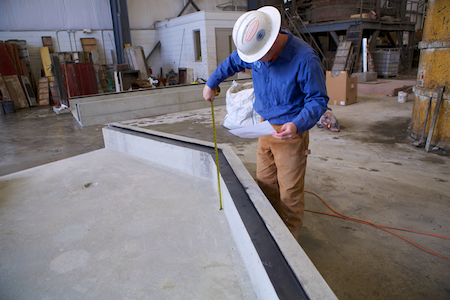
According to Gilbert, Putnam Contracting Services was selected for the Center Hill Dam Rehabilitation project based on the firm’s status as one of just a few firms that can handle the size and scope of a typical dam project. “We were selected based on the best bid and not for being the cheapest,” Gilbert explains. “It’s all about our means and methods, and how well we’re working together with BAUER Foundation to get the dam shored up and safe for neighboring communities.”
Gilbert says precast concrete was a natural choice of materials for the trench. Because it was manufactured in controlled conditions – and away from the actual jobsite – Putnam Contracting Services was able to continue working on the project while Barger & Sons engineered and built the items. “We weren’t looking to do the traditional sequence of dig out, form up, and pour,” Gilbert says. “We were digging out until the precast truck pulled onsite and unloaded the items.”
Precast also allowed the contractor to achieve a level of precision that cannot be achieved with poured-in-place options. Also, two planes of elevation change had to be accommodated. “It wasn’t just plane-and-grade,” says Gilbert, whose team had the trench in place within 48 hours of unloading the Barger & Sons delivery truck. “We’ve been complimented on the work by both the specialty contractor and the project owner,” says Gilbert. “That definitely says something of our choice of Barger & Sons for the job.”
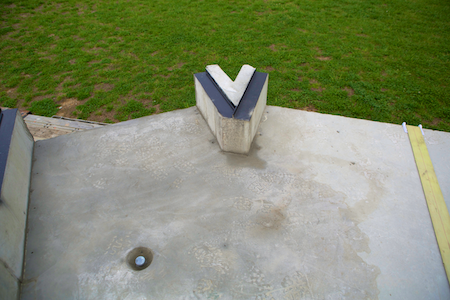
Martin Ing, president of Putnam Contracting Services and one of the precast trench designers, says that while other materials were discussed as possibilities, “when it came down to the wire, precast was the obvious choice.” Time was of the essence, says Ing, who moved quickly to come up with a design that incorporated pipes installed below-ground in order to keep the adjacent roadway openings as clear as possible for traffic.
“I asked Eric Barger if he was interested in handling this for us, and told him we’d have it designed and stamped within two days,” Ing recalls. “That gave Barger & Sons five days to make the pieces.” Once the precast trench was onsite, Putnam Contracting Services would have just two days to get it installed and ready to use. “Eric reviewed the plan and within an hour we were working together to meet this tight deadline.”
After going through several iterations with the project’s design engineer, Ing came up with a solution that stood up to the required “strength test” and that would work within the parameters provided. “We showed the drawing to the client, he approved it, and we released it for manufacture,” says Ing, who adds that precast allowed Putnam Contracting Services to install the product one day and then backfill it the next – something that’s not possible with poured-in-place. The latter, for example, requires forms and at least 3-4 days to cure. “We just didn’t have the time for that,” says Ing. “We needed the trench to be in place and usable immediately.”
Eric reviewed the plan and within an hour we were working together to meet this tight deadline.
Martin Ing - President at Putnam Contracting Services
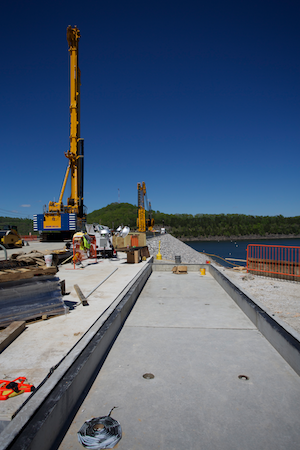
Center Hill Dam is one of hundreds of dams that are currently being monitored, overhauled, and secured nationwide. At Center Hill, the Corps identified the seepage problem through long-term dam monitoring, which stems from the type of karst limestone rock surrounding the foundation of the dam when constructed in the late 1940s. Total cost of the project is estimated at $295 million, of which about $140 million has been spent to date on investigations, design, and construction.
The seepage rehabilitation plan is a combination of grouting, completed between 2008 and 2010, and construction of a continuous concrete barrier wall for long-term stability, which is being installed from 2012 through 2014. As part of that initiative, a vertical concrete wall, at least two-feet thick, was constructed through the earthen dam and deep into the rock foundation below to prevent seepage from harming the earthen dam.
According to the Association of State Dam Safety Officials, the Federal Government has been working to protect Americans from dam failure through its National Dam Safety Program (NDSP). Led by the Federal Emergency Management Association (FEMA), NDSP is a partnership of the states, federal agencies, and other stakeholders to encourage individual and community responsibility for dam safety.
According to Ing, the precast trench has exceeded the project owner’s expectations and also helped Putnam Contracting Services quickly move on to the next phase of the dam rehabilitation project. “It turned out to be a very good solution and a successful project, thanks to Barger & Sons’ quick work,” says Ing, “and the fact that the products were accurate, aesthetic, and right on target dimensionally.”
